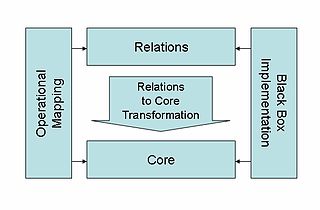Related Research Articles
XSLT is a language originally designed for transforming XML documents into other XML documents, or other formats such as HTML for web pages, plain text or XSL Formatting Objects, which may subsequently be converted to other formats, such as PDF, PostScript and PNG. Support for JSON and plain-text transformation was added in later updates to the XSLT 1.0 specification.
A computer language is a formal language used to communicate with a computer. Types of computer languages include:
In computer science, a preprocessor is a program that processes its input data to produce output that is used as input in another program. The output is said to be a preprocessed form of the input data, which is often used by some subsequent programs like compilers. The amount and kind of processing done depends on the nature of the preprocessor; some preprocessors are only capable of performing relatively simple textual substitutions and macro expansions, while others have the power of full-fledged programming languages.

The Meta-Object Facility (MOF) is an Object Management Group (OMG) standard for model-driven engineering. Its purpose is to provide a type system for entities in the CORBA architecture and a set of interfaces through which those types can be created and manipulated. MOF may be used for domain-driven software design and object-oriented modelling.
In software, an XML pipeline is formed when XML processes, especially XML transformations and XML validations, are connected.
Model Driven Architecture (MDA) is a software design approach for the development of software systems. It provides a set of guidelines for the structuring of specifications, which are expressed as models. Model Driven Architecture is a kind of domain engineering, and supports model-driven engineering of software systems. It was launched by the Object Management Group (OMG) in 2001.
The Object Constraint Language (OCL) is a declarative language describing rules applying to Unified Modeling Language (UML) models developed at IBM and is now part of the UML standard. Initially, OCL was merely a formal specification language extension for UML. OCL may now be used with any Meta-Object Facility (MOF) Object Management Group (OMG) meta-model, including UML. The Object Constraint Language is a precise text language that provides constraint and object query expressions on any MOF model or meta-model that cannot otherwise be expressed by diagrammatic notation. OCL is a key component of the new OMG standard recommendation for transforming models, the Queries/Views/Transformations (QVT) specification.
XSL-FO is a markup language for XML document formatting that is most often used to generate PDF files. XSL-FO is part of XSL, a set of W3C technologies designed for the transformation and formatting of XML data. The other parts of XSL are XSLT and XPath. Version 1.1 of XSL-FO was published in 2006.

A metamodel is a model of a model, and metamodeling is the process of generating such metamodels. Thus metamodeling or meta-modeling is the analysis, construction, and development of the frames, rules, constraints, models, and theories applicable and useful for modeling a predefined class of problems. As its name implies, this concept applies the notions of meta- and modeling in software engineering and systems engineering. Metamodels are of many types and have diverse applications.
Metadata publishing is the process of making metadata data elements available to external users, both people and machines using a formal review process and a commitment to change control processes.

ATL is a model transformation language and toolkit developed and maintained by OBEO and AtlanMod. It was initiated by the AtlanMod team. In the field of Model-Driven Engineering (MDE), ATL provides ways to produce a set of target models from a set of source models.

QVT (Query/View/Transformation) is a standard set of languages for model transformation defined by the Object Management Group.
A model transformation, in model-driven engineering, is an automated way of modifying and creating platform-specific model from platform-independent ones. An example use of model transformation is ensuring that a family of models is consistent, in a precise sense which the software engineer can define. The aim of using a model transformation is to save effort and reduce errors by automating the building and modification of models where possible.
A model transformation language in systems and software engineering is a language intended specifically for model transformation.

Eclipse Modeling Framework (EMF) is an Eclipse-based modeling framework and code generation facility for building tools and other applications based on a structured data model.

A template processor is software designed to combine templates with data to produce resulting documents or programs. The language that the templates are written in is known as a template language or templating language. For purposes of this article, a result document is any kind of formatted output, including documents, web pages, or source code, either in whole or in fragments. A template engine is ordinarily included as a part of a web template system or application framework, and may be used also as a preprocessor or filter.
Kermeta is a modeling and programming language for metamodel engineering.
Domain-specific multimodeling is a software development paradigm where each view is made explicit as a separate domain-specific language (DSL).
SIGNAL is a programming language based on synchronized data-flow : a process is a set of equations on elementary flows describing both data and control.

An XML transformation language is a programming language designed specifically to transform an input XML document into an output document which satisfies some specific goal.
References
- ↑ The Lx transformation language set home page Archived 2012-07-10 at archive.today . Lx.mii.lu.lv (2007-10-08). Retrieved on 2013-08-10.
- ↑ MOLA pages. Mola.mii.lu.lv. Retrieved on 2013-08-10.